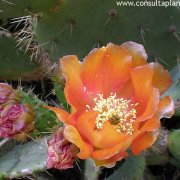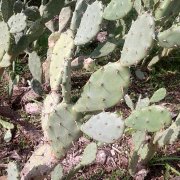Care of the cactus Opuntia ficus-indica or Prickly pear |
|
The genus Opuntia, of the Cactaceae family, comprises some 300 species of cacti distributed throughout Mexico, the United States, and Central and South America. Some species are: Opuntia ficus-indica, Opuntia linguiformis, Opuntia leucotricha, Opuntia engelmannii, Opuntia bergeriana, Opuntia santa-rita, Opuntia rufida, Opuntia robusta, Opuntia microdasys, Opuntia aciculata, Opuntia basilaris, Opuntia durangensis, Opuntia subulata, Opuntia polyacantha, Opuntia valida, Opuntia macrocentra, Opuntia chlorotica, Opuntia lindheimeri, Opuntia auberi, Opuntia atrispina, Opuntia phaeacantha, Opuntia vestita, Opuntia spinulifera. Common names: Prickly pear, Barbary fig, Indian fig opuntia, Cactus pear, Fig opuntia, Spineless cactus. This species is native to Mexico. They are shrubby cacti that reach more than 3 meters (9.84 feet) in height that develop a trunk with age. The flattened oval segments are light green in color. They have 2 kinds of spines in the glochids of the areolas: some are hard and long and others are hairy. The flowers appear at the edges of the segments and can be yellow or red. They bloom in summer. The oval fruits are edible. Prickly pear is used in rockeries, on dry slopes, to form impenetrable hedges, and in pots when young. It's ideal for Mediterranean coastal gardens. Opuntia ficus-indica needs full sun exposure and a hot, dry climate like the Mediterranean climate; young plants prefer semi-shade. It resists light and occasional frosts. The soil must be very well drained: use normal garden soil with plenty of coarse sand. The planting is done in spring. Water moderately all year long, waiting for the substrate to dry completely. Indian fig opuntia resists drought well. Fertilize with a little organic matter in early spring. Cactus pear does not need pruning. Opuntia ficus-indica is a very resistant plant to the usual pests and diseases but sensitive to excessive watering. Prickly pear is fairly easily propagated by segment cuttings in summer. |
Images of the cactus Opuntia ficus-indica or Prickly pear |
Find plants
Opuntia ficus-indica or Prickly pear | Care and Growing
© 2026 FavThemes





